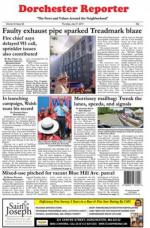July 17, 2019
By Nicolas V. Serna
Bostonians have long thought of traffic like the weather: a frustrating fact of life entirely out of our control. And while our weather might not be quite the worst in the world, our rush-hour traffic is, at least according to the national data firm Inrix.
Past attempts to fix this problem by building new capacity on our roads haven’t worked. Constructing new roadways is expensive and only induces new demand, leading to a Sisyphean dilemma where traffic relief appears close but is never quite reached. Just ask a rush hour driver inching across the Zakim Bridge, the jewel of the $24 billion Big Dig.
Since the completion of the Big Dig, we’ve essentially thrown up our hands and accepted defeat. But other regions of the country have been moving ahead.
Several large metropolitan areas, including Los Angeles, Chicago and Dallas, use “time of day” pricing as a tool to manage congestion on key commuting corridors, and it’s time for Boston to do the same. Congestion pricing — transportation parlance for using tolls — nudges drivers to avoid driving at the busiest times on the busiest roads or to choose alternate modes of transportation. Cities have found it to be a three-for-one solution: reducing clogged roads, lessening harmful air pollution, and generating revenue to provide commuters with more options.
Unsurprisingly, Boston lawmakers have begun considering such a policy. Given Boston’s acutely jammed arteries, the income profile of drivers and the myriad associated health risks of vehicle emissions, the time is right for us to be testing this tool. Ultimately, only a few people need to change their behavior to dissipate the familiar red-brake-light glare: Moving 5 percent of rush hour drivers off the road can increase traffic speeds by 20 percent or more.
Other cities are showing that it works. London cut its traffic congestion by 30 percent. Stockholm reduced congestion by 20 percent. New York City expects to save drivers and bus passengers 140,000 hours of travel time each day.
Critics of congestion pricing rightly question the policy’s fairness: Efficiency isn’t equity. Any road-pricing policy must address important concerns about whether it unduly burdens low-income commuters who are just trying to get to work without yet another fee.
Greater Boston’s travel demographics suggest there need not be a trade-off between equity and efficiency. Analysis of the underlying data generated from MassDOT’s most recent Massachusetts Travel Survey reveals who actually drives into downtown Boston on a typical workday. Only a small share of commuters — approximately one in 50 — from Boston’s surrounding communities both drive into the region’s central area and come from households that make less than median household income. An overwhelming 98 percent of commuters who live around Boston either come from above-median-income households, don’t commute into the city, and wouldn’t be subject to tolls or take other modes of transit.
Toll increases could still negatively impact the 2 percent who drive and are below median income. Yet their small number points to the feasibility of providing discounts or waivers: Shielding these drivers would not undermine a policy’s ability to reduce congestion and/or raise revenue for improved public transportation. New York has already taken this approach, exempting residents who make less than $60,000 per year.
Congestion pricing also helps to reduce air pollution. Auto emissions are the largest source of air pollution in Massachusetts and communities adjacent to highways disproportionately bear the costs of that pollution, which can cause significant health risks including asthma and premature birth.
A 2017 study found that of Boston’s residents who live within a quarter-mile of a freeway, nearly a quarter live below the poverty line and more than a third are nonwhite. Meanwhile, four in 10 households within these areas don’t even own a vehicle. In Boston, those least likely to use cars are those most likely to breathe in harmful tailpipe emissions. Congestion pricing can help offset that imbalance.
We could implement congestion pricing in three phases: a near-term pilot on existing tolled roads, a medium-term policy on congested roads — such as allowing solo drivers to use carpool lanes for a fee on I-93 — and a long-term comprehensive strategy for the region. We should check and correct for equity each step of the way. Over the long-term, the region can consider congestion pricing as an alternative to more regressive taxes (e.g. the sales tax) and more tightly align the burden of highway costs with drivers using those roads.
Residents of Greater Boston already bear the costs of congestion, through lost time, higher driving costs, and worse health. The status quo is unfair for low-income workers and historically under-served communities. We can either stay stuck in place, or we can begin a process of testing and understanding pricing policies that have worked well elsewhere. Congestion pricing can improve the equity of our transportation system while moving us more efficiently.
Drivers and public transit riders might find relief yet.
Nicolas V. Serna graduated from Harvard Kennedy School and Harvard Business School, where he conducted research with Transportation for Massachusetts. He is a native of Andover, Massachusetts. This article was first published on July 15 by WBUR 90.9FM. The Reporter and WBUR share content through a partnership.


